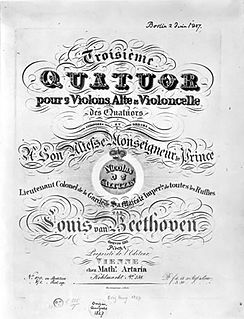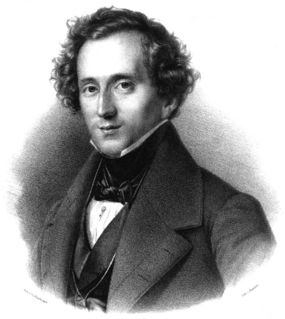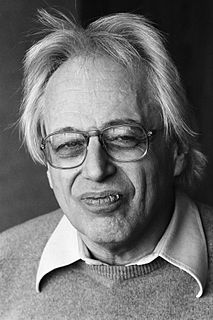
The String Quartet No. 13 in B♭ major, Op. 130, by Ludwig van Beethoven was completed in November 1826. The number traditionally assigned to it is based on the order of its publication; it is actually Beethoven's 14th quartet in order of composition. It was premiered in March 1826 by the Schuppanzigh Quartet and dedicated to Nikolai Galitzin on its publication in 1827.

The Octet in F major, D. 803 was composed by Franz Schubert in March 1824. It was commissioned by the renowned clarinetist Ferdinand Troyer and came from the same period as two of Schubert's other major chamber works, the 'Rosamunde' and 'Death and the Maiden' string quartets.
The Variations on a Nursery Tune for piano and orchestra, Op. 25, were written by Ernst von Dohnányi in 1914. It is subtitled "For the enjoyment of friends of humor, to the annoyance of others" on the manuscript, though he omitted this inscription on the concert program and on the published edition, fearing that it might sound somewhat provocative. The work was premiered in Berlin on 17 February 1914.
Sergei Prokofiev's Violin Sonata No. 2 in D Major, Op. 94a, was based on the composer's own Flute Sonata in D, Op. 94, written in 1942 but arranged for violin in 1943 when Prokofiev was living in Perm in the Ural Mountains, a remote shelter for Soviet artists during the Second World War. Prokofiev transformed the work into a violin sonata at the prompting of his close friend, the violinist David Oistrakh. It was premiered on 17 June 1944 by David Oistrakh and Lev Oborin.
Songs Without Words is a series of short lyrical piano works by the Romantic composer Felix Mendelssohn written between 1829 and 1845. His sister, Fanny Mendelssohn, and other composers also wrote pieces in the same genre.
Variations on a Theme of Corelli, Op. 42, is set of variations for solo piano, written in 1931 by the Russian composer Sergei Rachmaninoff. He composed the variations at his holiday home in Switzerland.
The String Quartet No. 2 in A minor, Op. 13, was composed by Felix Mendelssohn in 1827. Written when he was 18 years old, it was, despite its official number, Mendelssohn's first mature string quartet. One of Mendelssohn's most passionate works, the A minor Quartet is one of the earliest and most significant examples of cyclic form in music.

The String Quartet No. 3 in D major, Op. 44, No. 1, was composed by Felix Mendelssohn(1809-1847) in July of 1838 at the age of 29. It premiered in 1839, then was published later in 1840. Quartet No. 3 in D minor a traditional quartet, comprising two violins, a viola, and a cello. The piece is part of the Op. 44 set of 3 string quartets that Mendelssohn dedicated to the Crown Prince of Sweden.
Dmitry Kabalevsky's Preludes, Op. 38 are a set of 24 piano pieces in the Chopinian model, each based on a folksong and each in a different key. It was composed in 1943–44, and dedicated to Nikolai Myaskovsky, his teacher. It is one of a number of examples of music written in all 24 major and minor keys.

The Piano Trio No. 1 in B major, Op. 8, by Johannes Brahms was completed in January 1854, when the composer was only twenty years old, published in November 1854 and premiered on 13 October 1855 in Danzig. It has often been mistakenly claimed that the first performance had taken place in the United States. Brahms produced a revised version of the work in summer 1889 that shows significant alterations so that it may even be regarded as a distinct (fourth) piano trio. This "New Edition", as he called it, was premiered on 10 January 1890 in Budapest and published in February 1891.
Dmitry Kabalevsky's Piano Sonata No. 2 in E-flat major, Op. 45 was composed in 1945 and dedicated to Emil Gilels. It is the most vast and dramatic of Kabalevsky's three sonatas. A War Sonata such as Sergei Prokofiev's trilogy, its first movement has been compared to that of Dmitri Shostakovich's Symphony No. 7.
The six string quartets, K. 155–160, were composed by Wolfgang Amadeus Mozart in late 1772 and early 1773 when Mozart was sixteen and seventeen years of age. Because they were composed in Milan while he was working on his opera Lucio Silla, they are popularly known as the Milanese Quartets. Before this set was composed, Mozart had written one earlier string quartet, so these six quartets are ordinally numbered from No. 2 to No. 7. The quartets are written in a plan of keys of D-G-C-F-B♭-E♭ following the circle of fifths.
The Partita for orchestra with a solo soprano by the Italian composer Luigi Dallapiccola was composed between 1930 and 1932.
Edvard Grieg's String Quartet No. 1 in G minor, Op. 27, is the second of three string quartets written by the composer. The first, in D minor, was an early work, now lost, written in the early 1860s at the request of his teacher, Carl Reinecke. The third quartet, in F major, remained incomplete at the composer's death.
Symphony No. 1 in B-flat major was the first symphony composed by Charles Villiers Stanford an Irish composer, music teacher, and conductor. It was written in 1876 to compete for a prize offered by the proprietors of the Alexandra Palace. It came second out of 46 entries earning a prize of £5. The symphony was dedicated to the tenor Arthur Duke Coleridge who had been a friend of Stanford's at Cambridge. It was first played at The Crystal Palace in London in 1879 but was never published or performed again in Stanford's lifetime.

The Hungarian composer György Ligeti published three string quartets: two string quartets proper and a student piece from 1950 published toward the end of his life. The first two quartets represent his early period, inspired by Béla Bartók, and middle period, which was largely micropolyphonic.
The Violin Sonata in B minor, P 110, is a sonata for violin and piano by Italian composer Ottorino Respighi, completed in 1917. It is one of Respighi's major large-scale chamber works.
The Symphony No. 3 in B minor by the Ukrainian composer Borys Lyatoshynsky was completed in 1951, with the final movement themed "Peace will conquer war." The symphony was first performed in Kyiv on 23 October 1951, by the Kyiv Philharmonic, conducted by Natan Rakhlin. Criticised by the Soviet authorities on ideological grounds, the composer was forced to rework the symphony, and to remove the subtitle of the finale. The first performance of the revised version took place in Leningrad in 1955.
Seis canciones castellanas is a collection of 6 songs for voice and piano by Spanish Basque composer Jesús Guridi. They were inspired by traditional songs collected by Cesáreo Garda in Candeleda in 1936 for the movie La malquerida. Guridi composed film music, but the Spanish Civil War interrupted the production, and the movie was finished only in 1940.




